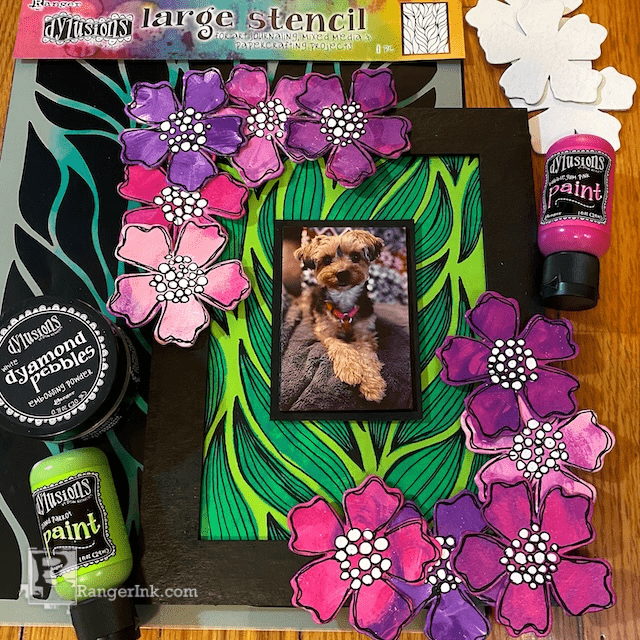by Tammy Tutterow
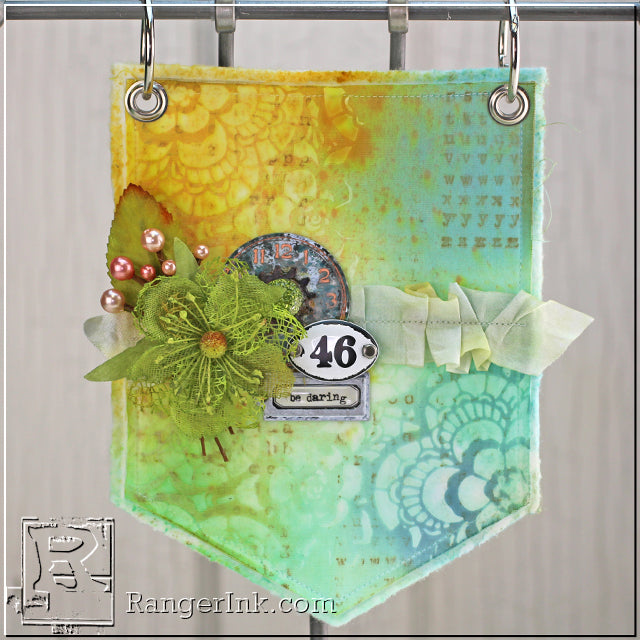
Transparent Texture Paste Resist on Fabric by Tammy Tutterow
- Materials
- Instructions
- Ranger Texture Paste: Transparent Matte
- Tim Holtz Distress Spray Stains: Tumbled Glass, Fossilized Amber, Cracked Pistachio
- Tim Holtz Distress Ink Pads: Gathered Twigs
- Tim Holtz Distress® Sprayer
- Ranger Mini Blending Tool
- Dina Wakley Media Palette Knife
- Ranger Non-Stick Craft Sheet™
- Ranger Heat it™ Craft Tool
- Ranger Adhesive Foam Rolls
- Ranger Wonder Tape™
- Tim Holtz Idea-ology: Timepiece, Sprocket Gear, Gumdrop, Tag Label, Plaquette, Grid Blocks
- Tim Holtz Stampers Anonymous Layering Stencil: THS034 Lace
- Tim Holtz Stampers Anonymous Cling Stamps: 226 Documented
- Petaloo: Flower, Leaf, Pearls
- May Arts: 1" Silk Ribbon
- other: fabric, batting, adhesive foam sheet (Phoomph)
Instructions
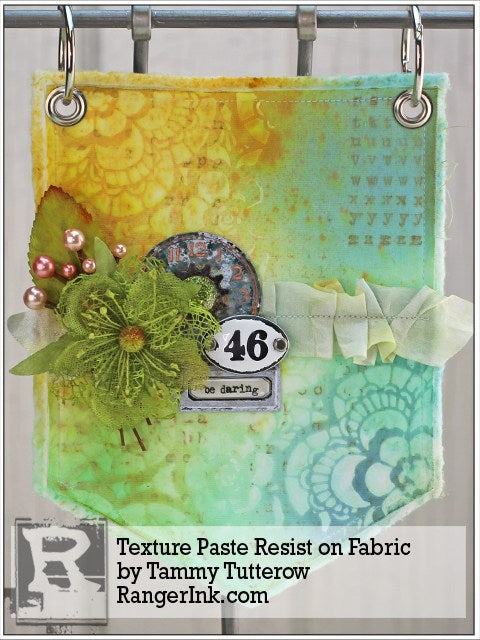 On of the many things I love about Ranger’s Texture Paste line is the way it bonds to many different surfaces. I especially love the way it works on fabric! Today I am a shraring a tutorial to demonstrate how I used the Transparent Matte Texture Paste to create a resist on fabric.
On of the many things I love about Ranger’s Texture Paste line is the way it bonds to many different surfaces. I especially love the way it works on fabric! Today I am a shraring a tutorial to demonstrate how I used the Transparent Matte Texture Paste to create a resist on fabric.
 The surface I am working on is a fabric banner that I created using plain white cotton muslin, a layer of Phoomph (double sided adhesive foam) to add structure, and a layer of natural cotton batting. You can find a pattern and instructions for how I create my banners on my blog: Tammy Tutterow Art Banners.
The surface I am working on is a fabric banner that I created using plain white cotton muslin, a layer of Phoomph (double sided adhesive foam) to add structure, and a layer of natural cotton batting. You can find a pattern and instructions for how I create my banners on my blog: Tammy Tutterow Art Banners.
 Place a stencil over the fabric. Use a palette knife to spread Transparent Matte Texture Paste onto the fabric through the stencil. The texture paste should be no thicker than the stencil. Use the side of the palette knife to skim over the stencil to remove the excess texture paste.
Place a stencil over the fabric. Use a palette knife to spread Transparent Matte Texture Paste onto the fabric through the stencil. The texture paste should be no thicker than the stencil. Use the side of the palette knife to skim over the stencil to remove the excess texture paste.
If the excess paste is clean, you can return it to the jar. Clean the stencil with water while the texture paste is still wet.
 Continue to add areas of design with the texture paste and the stencil. Don’t worry if you have an area in the center where the pattern doesn’t match up (as shown). You can embellish over any mismatched areas of pattern.
Continue to add areas of design with the texture paste and the stencil. Don’t worry if you have an area in the center where the pattern doesn’t match up (as shown). You can embellish over any mismatched areas of pattern.
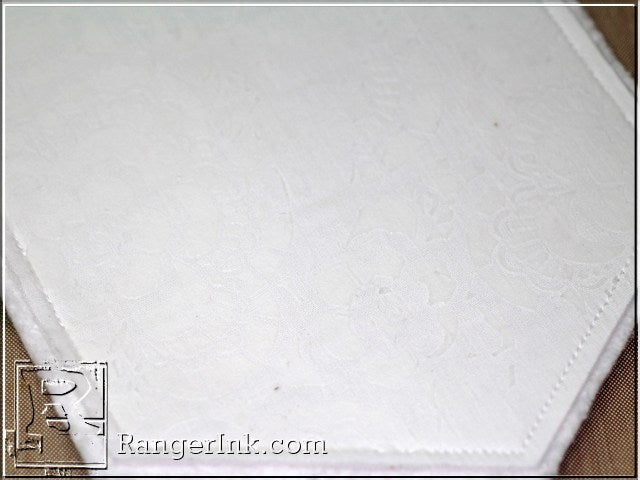 Set the fabric aside to dry. While you are waiting for the texture paste to dry, you can prep any embellishments. You can test for dryness by lightly touching your finger to the texture paste. It will feel tacky while it is wet.
Set the fabric aside to dry. While you are waiting for the texture paste to dry, you can prep any embellishments. You can test for dryness by lightly touching your finger to the texture paste. It will feel tacky while it is wet.
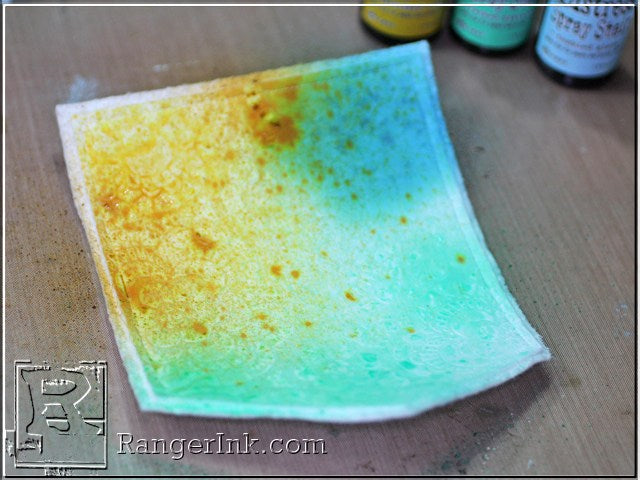 When the texture paste is dry, lightly mist the surface with water. Mist an assortment of Distress Spray Stains onto the damp fabric. (Colors shown: Cracked Pistachio, Fossilized Amber, and Tumbled Glass.)
When the texture paste is dry, lightly mist the surface with water. Mist an assortment of Distress Spray Stains onto the damp fabric. (Colors shown: Cracked Pistachio, Fossilized Amber, and Tumbled Glass.)
 Mist the Distress Spray Stain with water to blend it. You do not need to mist it until it is dripping wet, only use enough to water to blend the colors as desired.
Mist the Distress Spray Stain with water to blend it. You do not need to mist it until it is dripping wet, only use enough to water to blend the colors as desired.
 Blot the surface with a dry cloth.
Blot the surface with a dry cloth.
 Dry the fabric with a heat tool. You will see that many of the areas with Texture Paste will remain white where the Texture Paste resists the stain.
Dry the fabric with a heat tool. You will see that many of the areas with Texture Paste will remain white where the Texture Paste resists the stain.
Because of the nature of fabric, some color will wick and spread under the resist. The more water you add to blend, the more wicking you will get. The finished fabric will have a Batik look.
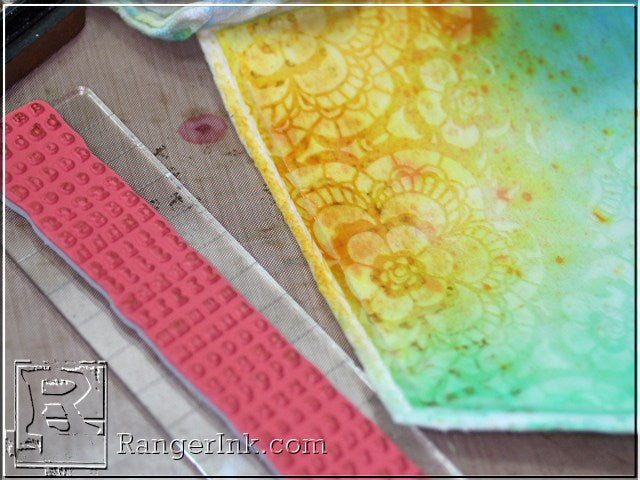 To add more background detail, ink a stamp with Distress Ink (color shown: Gathered Twigs). Stamp the image onto the surface over the texture paste.
To add more background detail, ink a stamp with Distress Ink (color shown: Gathered Twigs). Stamp the image onto the surface over the texture paste.
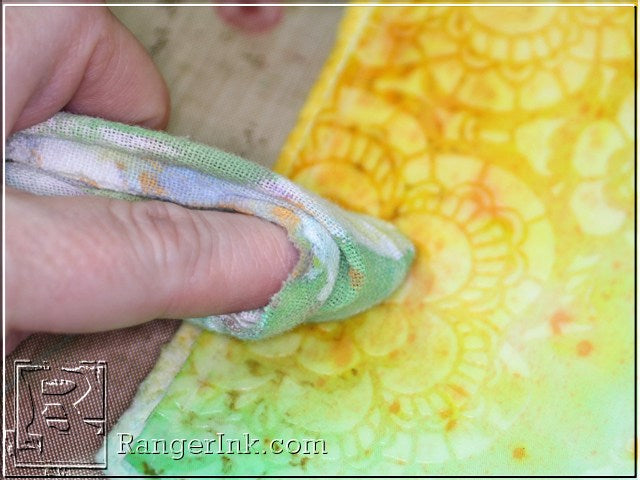 Buff over the texture paste with a dry cloth to remove any stamp ink from the design. The image will remain on the fabric, making it look as though it is behind the stenciled design.
Buff over the texture paste with a dry cloth to remove any stamp ink from the design. The image will remain on the fabric, making it look as though it is behind the stenciled design.
 Continue adding random stamping over the surface. Remember to buff the texture paste with a dry cloth while the ink is wet.
Continue adding random stamping over the surface. Remember to buff the texture paste with a dry cloth while the ink is wet.
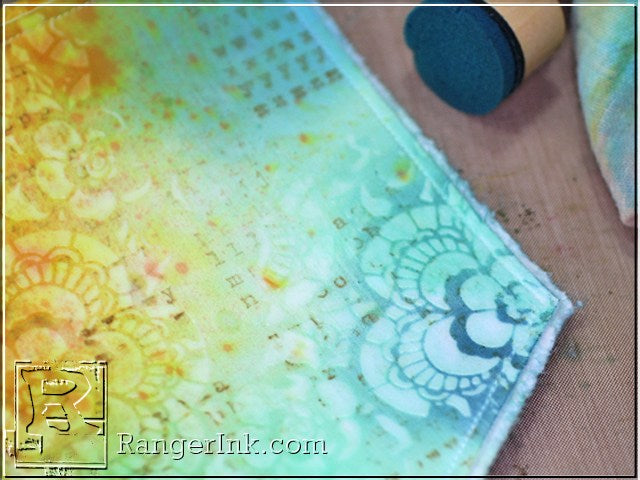 If desired, blend Distress Ink with an ink blending tool over some of the stenciled designs to add more contrast and emphasize the stenciled design. As before, buff over the texture paste to remove any ink from the top of the texture paste.
If desired, blend Distress Ink with an ink blending tool over some of the stenciled designs to add more contrast and emphasize the stenciled design. As before, buff over the texture paste to remove any ink from the top of the texture paste.
Tip: I keep an ink blending tool for each color family. To keep the ink from being too bold, I use the blending tool without reinking it. If I want subtle inking, I generally find I have enough ink in my foam without needing to ink it up with an ink pad.
 Color coordinating ribbon by skimming over it with ink blending tools. Again, I use the ink already on the foam without reinking to keep the ink very light. Mist the ribbon lightly with water to blend the color. Blot the ribbon with a dry cloth to remove excess moisture and then dry with a heat tool.
Color coordinating ribbon by skimming over it with ink blending tools. Again, I use the ink already on the foam without reinking to keep the ink very light. Mist the ribbon lightly with water to blend the color. Blot the ribbon with a dry cloth to remove excess moisture and then dry with a heat tool.
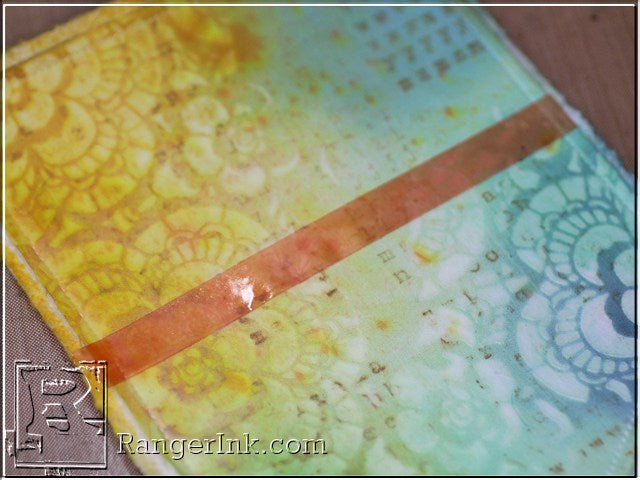 To create a ruched ribbon effect, lay a strip of Wonder Tape across the surface. Remove the red tape liner.
To create a ruched ribbon effect, lay a strip of Wonder Tape across the surface. Remove the red tape liner.
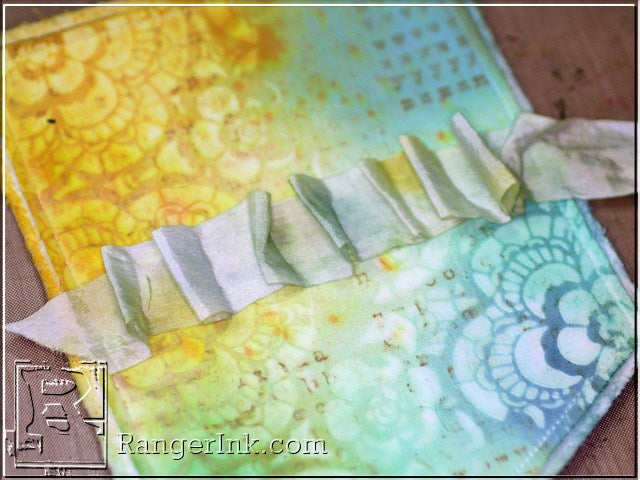 Lay the ribbon onto the tape in “waves”, with loops sticking up and some areas stuck down flat to the tape.
Lay the ribbon onto the tape in “waves”, with loops sticking up and some areas stuck down flat to the tape.
 Sew along the center of the ribbon flattening out the upright loops as you sew.
Sew along the center of the ribbon flattening out the upright loops as you sew.
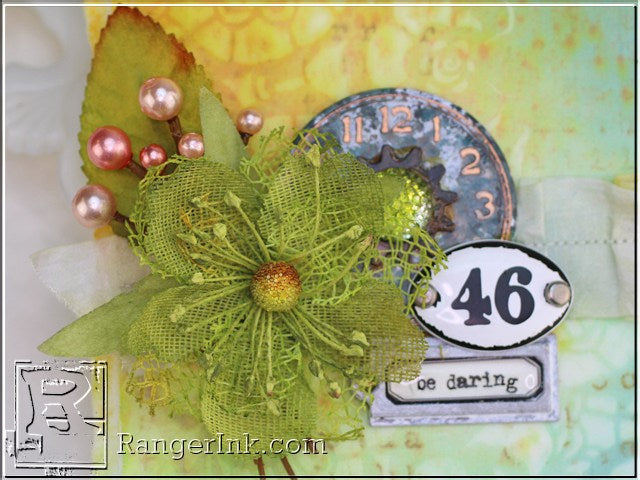 Add embellishments to the banner as desired. For this banner I combined pearls, a leaf, and a flower with assorted metal embellishments. Add Picket Fence Distress Paint to your metal pieces to add a vintage shabby chic feel.
Add embellishments to the banner as desired. For this banner I combined pearls, a leaf, and a flower with assorted metal embellishments. Add Picket Fence Distress Paint to your metal pieces to add a vintage shabby chic feel.
 Completed banners can be displayed in a variety of ways- they can be tied or sewn together, hung on a line with clips, or displayed on small stands.
Completed banners can be displayed in a variety of ways- they can be tied or sewn together, hung on a line with clips, or displayed on small stands.
Tip- I add fabric grommets to the corners to make it easy to tie them together. You can find large fabric grommets in the notions section of fabric stores.
 I love resist techniques because they add a bit of a mystery to the project and make anyone looking wonder what order things were applied. They make a project seem complicated when in fact it was really easy to create!
I love resist techniques because they add a bit of a mystery to the project and make anyone looking wonder what order things were applied. They make a project seem complicated when in fact it was really easy to create!
 Not so sure about crafting on fabric? No worries! You can use this technique on paper too! The look is slightly different, but still very easy and amazing!
Not so sure about crafting on fabric? No worries! You can use this technique on paper too! The look is slightly different, but still very easy and amazing!







